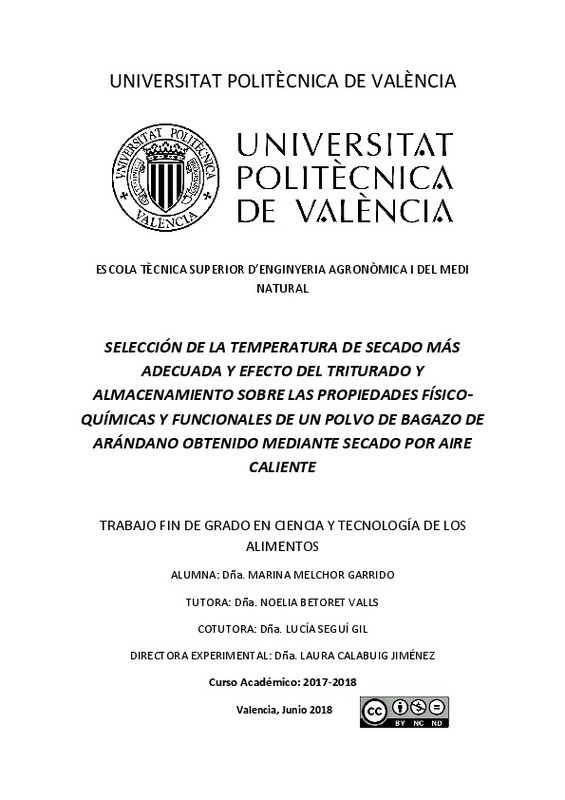|
Resumen:
|
[ES] La reutilización de residuos generados por la industria agroalimentaria incluye el
aprovechamiento de la piel y las semillas de muchas frutas y hortalizas, que son
materia prima muy rica en compuestos bioactivos. ...[+]
[ES] La reutilización de residuos generados por la industria agroalimentaria incluye el
aprovechamiento de la piel y las semillas de muchas frutas y hortalizas, que son
materia prima muy rica en compuestos bioactivos. Los arándanos son unos frutos rojos
muy populares ricos en antocianinas, ácidos fenólicos y flavonoides. Alrededor del 15%
de la producción de estos frutos es destinada al procesado, generando así un
subproducto con características muy interesantes para la industria. Por otro lado, el
mercado de productos deshidratados como los polvos de fruta se ha incrementado ya
que se pueden utilizar como ingredientes en la industria de bebidas, aditivos para
alimentos procesados, agentes saborizantes o también como colorantes naturales. Así
pues, la obtención de polvo de arándano procedente del subproducto generado tras su
procesado plantea muchos beneficios tanto a nivel económico como a nivel
medioambiental y de salud.
El presente trabajo consta de dos objetivos: determinar la temperatura de secado más
apropiada para la obtención de un polvo de arándano con propiedades funcionales y
estudiar la evolución con el tiempo de las características del polvo obtenido. Para ello,
se elaboró zumo de arándano y se obtuvo el bagazo fresco, que fue caracterizado en
términos de actividad de agua, humedad, sólidos solubles, color y antioxidantes y
posteriormente secado a dos temperaturas diferentes, 60 y 70 °C, hasta alcanzar una
actividad de agua menor a 0,3. Una vez decidida la temperatura de secado, el bagazo
seco a dicha temperatura se trituró en dos condiciones diferentes con la finalidad de
obtener dos granulometrías del polvo que se almacenaron durante veinte semanas en
bolsas opacas e impermeables en una cámara con humedad relativa controlada.
Ambas granulometrías del polvo de arándano se caracterizaron en términos de
actividad de agua, humedad, color, sólidos solubles, tamaño de partícula, fibra y
antioxidantes cada cuatro semanas de su almacenamiento (exceptuando el tamaño de
partícula, la fibra y los sólidos solubles que tan solo se midieron al inicio del mismo).
Los resultados del presente trabajo sugieren que todo y que la temperatura de secado
afecta la actividad antioxidante, el aumento de 60 a 70 °C no tiene un efecto de
deterioro de la misma lo suficientemente relevante. Los resultados también sugieren
que la combinación del proceso de secado seguido de un triturado da como resultado
un polvo de arándano que, independientemente de su granulometría, es muy estable
en el tiempo.
[-]
[EN] The re-use of the organic waste generated by the food industry includes the utilization
of the peel and seeds of numerous fruits and vegetables known of being very rich raw
material in bioactive compounds. Blueberries ...[+]
[EN] The re-use of the organic waste generated by the food industry includes the utilization
of the peel and seeds of numerous fruits and vegetables known of being very rich raw
material in bioactive compounds. Blueberries are very popular soft berries rich in
antocianines, phenolic acids and flavonoids. Around 15% of the production of these
fruits is destined to processing, generating thus such an interesting by-product for the
industry. At the same time, the dehydrated products market such as food powders has
increased since they can be used as ingredients in the beverage industry, additives for
processed foods, flavouring agents or natural dyes. Therefore, obtaining blueberry
powder from by-products generated after its processing has a lot of benefits which are
not only for the economy but also for the environment and health.
The present study has two objectives: to establish the most appropriate drying
temperature for obtaining a blueberry powder with functional properties and to study
the evolution throughout time of the characteristics of this powder. Blueberry juice
was produced in order to obtain fresh pomace, which was characterized in terms of
activity water, moisture, water-soluble solids, color and antioxidants and was later
dried at two different temperatures, 60 and 70 °C, until an activity water lower than
0,3 was reached. Once the drying temperature decided, the pomace dried at that
temperature was grinded under two different conditions with the purpose of obtaining
two grain size of the powder which were stored away during twenty weeks in opaque
and waterproof bags in a relative humidity controlled chamber. Both grain sizes of the
blueberry powder were characterized in terms of activity water, moisture, color,
water-soluble solids, particle size, fiber and antioxidants every four weeks of their
storage (excluding the particle size, the fiber and the water-soluble solids which were
only obtained at the beginning of the storage).
The results of the present work suggest that even though the drying temperature
affects the antioxidant activity, the increase from 60 to 70 °C does not have a loss of
antioxidant activity relevant enough. The results also suggest that the combination of
the drying process with grinding results in a blueberry powder which, regardless of its
grain size, is very stable in time.
[-]
|







